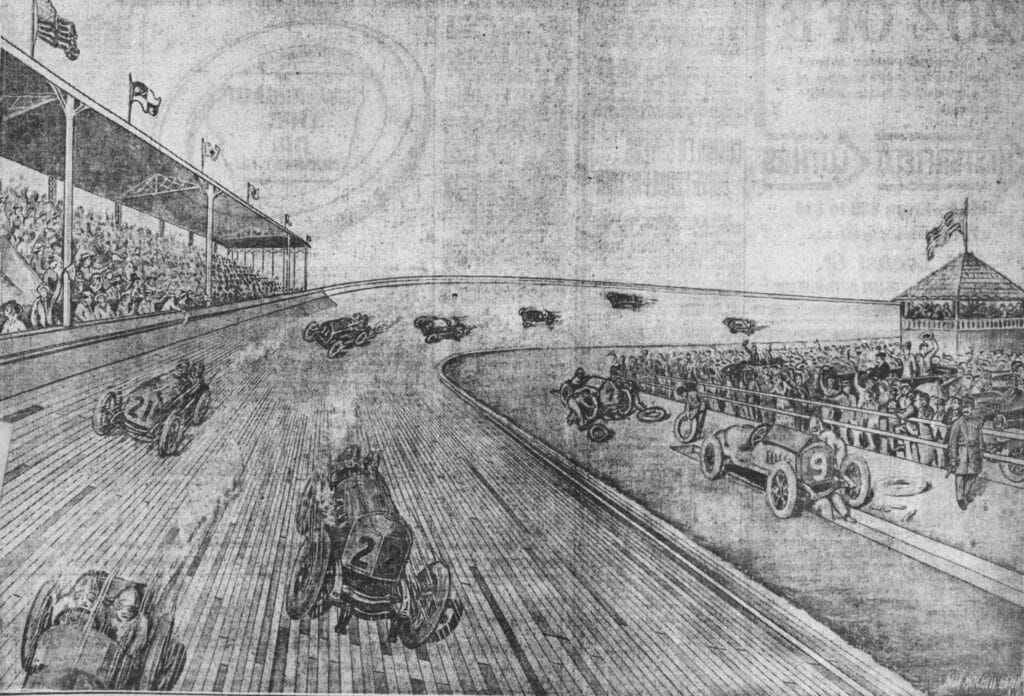The Elbert Files: Central Iowa’s wooden speedway


It’s difficult to imagine today, but 109 years ago Valley Junction was briefly the home of a mile-long, banked, oval racetrack made of wood.
Yes, wood. The undercarriage was wood. The racing surface, including banked turns, was two-by-fours laid on edge and nailed together. Bleachers were wood, as were guardrails that were more for looks than protection.
During the first major race, on Aug. 7, 1915, two men were killed. One driver died after his car blew a tire and went over a guardrail; a second blowout caused another racecar to roll to the infield, killing a mechanic, who in those days rode alongside the driver during races.
But I’m getting ahead of myself.
Let’s back up to when John “Jack” Prince, a former British bicycle and motorcycle racer, came to town.
After Prince quit racing, he sold bicycles and built wooden bicycle racetracks. Then, he moved on to speedways for motorcycles and cars. His first two wooden speedways were in California in 1910 and 1911, followed by projects in Chicago and Omaha.
In 1915, as the Omaha and Chicago tracks were nearing completion, Omaha backers introduced Prince to Des Moines business leaders who helped raise $100,000 to build a wooden speedway here.
Five sites, including two near the Iowa State Fairgrounds, were considered before Valley Junction was chosen. A 10-year lease was signed in mid-May for farmland south of Railroad Avenue and west of today’s 14th Street in West Des Moines.
On June 1, wooden posts outlining the track were driven into the ground by state and local officials and the president of the Chamber of Commerce. More than 200 laborers completed construction in about 50 days.
Opening day was Sunday, July 25, and featured an elaborate program that included a reprise of a racecar-airplane contest that had captivated Iowans at the 1914 State Fair.
At the fair, a biplane completed nearly four laps above a half-mile oval racetrack, one more than racecar driver Eddie Rickenbacker. In Valley Junction, on the banked wooden, one-mile speedway, racecars went much faster, although the next day’s newspaper did not report who won.
Another highlight of opening day was a time trial. Driver Eddie O’Donnell, behind the wheel of a 100 horsepower Fiat, averaged 103 miles an hour for two miles and just over 100 miles an hour for five miles – speeds faster than that year’s Indianapolis 500.
The day’s big winner was law enforcement. The sheriff ticketed promoters for holding an event in violations of Iowa blue laws that prohibited doing businesses on Sunday, and Des Moines police ticketed more than 100 motorists for either speeding – “driving 30 (or 35) mi. an hour” – or violating a noise ordinance by opening muffler cutouts to sound like racecars.
The marquee event of 1915’s four race dates was a 300-mile, 12-driver race on Aug. 7.
It rained eight-tenths of an inch the night before, which was later suggested as a contributor to the two deaths. Officials speculated that the rain caused some of the race surface boards to swell, creating bumps that damaged racecar tires.
Early in the race, driver Joe Cooper blew a rear tire coming off a curve. His car skidded sideways and went through the guardrail. Cooper was crushed. “He was dead by the time spectators reached him,” the Des Moines
Register reported.
The second fatality also began with a blowout, on a car driven by W.W. Chandler. His car also skidded and turned over, throwing the driver and his mechanic, Morris Keeler, who died. Chandler was also expected to die but recovered.
The wooden speedway hosted four events in 1916 with smaller crowds. It shut down in 1917 when the United States entered World War I.
The racetrack was disassembled in November 1917, and 1.8 million board-feet of lumber were advertised for sale at an “Extreme Bargain.”
According to various sources, 24 wooden speedways were built in the United States between 1910 and 1928; Prince was involved in 17.

Dave Elbert
Dave Elbert is a columnist for Business Record.




